
The Dow Theory is named after Charles H Dow, cofounder of the Wall Street Journal.
Although initially postulated for the stock market, forex traders can learn a lot from Dows Theory as it forms the basis for technical analysis which is the cornerstone of forex trading.
5 Tenets of the Dow Theory
- The Market Discounts Everything
- The Market Moves in 3 Types of Trends
- Primary Trends Form in 3 Phases
- Indices Must Confirm Each Other
- Volume Must Confirm Trend
The Market Discounts Everything
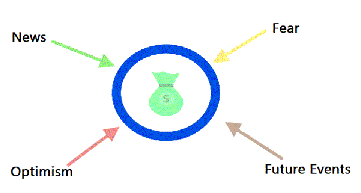
When Charles Dow said that the market discounted everything, he meant that before agreeing to pay a certain amount for a company’s stock, the investor would have done his homework.
He would have considered everything that could go right or wrong with the company even in the future.
For example, even if the company were to end its financial year in a loss, the shareholders would not be upset & sell off their stock, because they would have seen it coming.
This would mean that the price of a stock is a true reflection of the company’s value & no stock can be overvalued or undervalued.
This would also mean no portfolio manager would be able to outperform stock market indices.
Today, this part of the Dow Theory has been proven wrong because portfolio managers have been able to deliver returns, outperforming major stock market indices.
The Market Moves in 3 Types of Trends
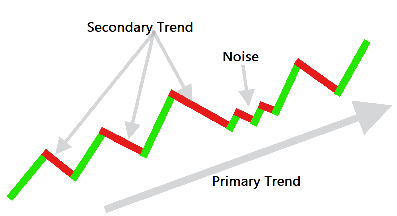
According to Charles Dow, every market moves in primary, secondary, & minor trends.
Primary trend
The first & most dominant market trend is called the primary trend which could either be upwards, or downwards; & could last for as long as a year.
Anytime the market is not in a recession, it means the primary trend is upward or bullish. However, when you hear that the market is in a recession, it means the primary market trend is downward or bearish.
Secondary trend
The second market trend is called the secondary trend which is always opposite to the primary trend & it manifests in the form of pullbacks (fighting the primary trend).
In an upward primary trend, the secondary trend can be spotted when price falls temporarily because those who bought earlier are selling & cashing out their profits.
In a downward primary trend, the secondary trend manifests when prices suddenly go up because of the activities of short sellers, who are buying in order to exit the market with their profits.
Secondary trends can last for months but are later subdued by the dominant primary trend.
Minor trend
The third & last type of trend lasts for some days & is called the minor trend & because it contains little price movement it’s considered market noise.
The key takeaway here is that secondary trends also known as pull backs are only temporary so you should not exit the market. The primary trend remains dominant regardless of the secondary trend or the noise.
The Primary Trend Consists of Three Phases
According to Charles Dow, primary trends unfold in 3 phases & smart investors will always be major players in these phases.
In an upward primary trend, these are the phases:
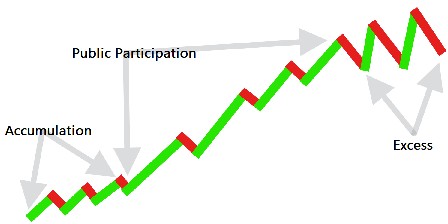
Phase 1: The first phase is the accumulation phase & here the smart investors begin buying at a lower price while the average investor is unaware that an upward trend is forming. The accumulation phase is characterized by the low volume of investors in the market.
Phase 2: The second phase is the public participation phase where the average investors become aware of a coming upward trend & begin buying. This is the longest phase & is characterized by a high volume of investors in the market & this pushes the price upwards.
Phase 3: The third & final phase is the excess phase where more average investors keep buying thus pushing the price even higher & the market becomes overbought.
In a downward primary trend, these are the phases:
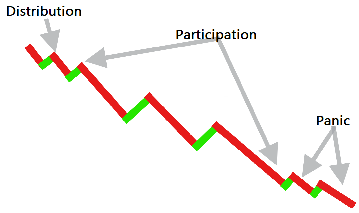
Phase 1: In a downward trend the first phase is the distribution phase where smart money investors start selling & exiting with their profits while the average investor still hopes the price will increase further. The exit of smart investors causes the price to start falling.
Phase 2: the next phase is the public participation phase where herd mentality sets in & many average investors begin to sell off to cut their losses. The volume of sellers in the market increases & this establishes the downward trend to continue for much longer. But some investors don’t sell as they remain optimistic.
Phase 3: the next phase in a downtrend is the panic phase where those investors who were optimistic realize it the trend may not be reversing anytime soon so they panic & selloff so that they don’t lose everything.
The key takeaway here is that you need to know when to jump on a trend, if you enter the market when the trend is dying out, you could be left with losses. This part of Dows Theory still holds true till today, especially in forex trading.
Indices Must Confirm Each Other
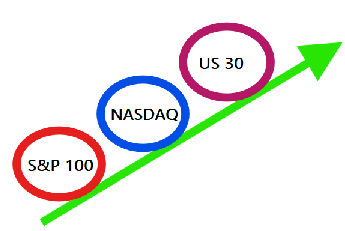
According to Charles Dow, before you can say a market sector is in an upward trend the market indices that monitor that sector must also be in an upward trend.
Charles Dow & his partners developed the Dow Jones Industrial Average DJIA (now known as the US30 index) & the Dow Jones Transportation Average DJTA (now obsolete) to monitor the performance of the stock market.
He postulated that for the stock market to be in an uptrend, both the DJIA & DJTA must also be moving in an uptrend & vice versa.
If this were to be applied to today’s market, then we could say for the tech sector to be in an upward trend, then the NASDAQ & S&P 100 indices should also be in an upward trend. This is because both indices are made up of similar tech stocks.
The key takeaway here is that you should lookout for correlation between instruments before trading them.
Some currency pairs are positively correlated so that when one is trending upwards the other is also supposed to be trending upwards & this could serve as confirmation that the currency pair trend is strong.
On the flip side some currency pairs are negatively correlated meaning they move in opposite directions when one Is trending upwards, the other should be trending downwards. This too can serve as confirmation of a trend.
Volume Must Confirm the Trend
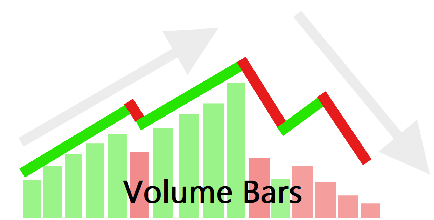
This part of the Dows theory states that in an upward trend, the volume of investors in the market must be high; & in a downward trend the volume of investors participating in the market must also be falling.
This implies that if you see a decreased volume of investors during an upward trend, then the trend may be approaching its end or be a false trend.
Also, if you notice that the volume of investors participating in the market is increasing during a downward trend, then the trend could be false, or it could be approaching its end.
Key takeaway is that you should always use your volume indicator when viewing charts so you can confirm is the trend is strong. (We will discuss how to use the volume indicator later in this module)
A Trend Persists Until a Clear Reversal Occurs
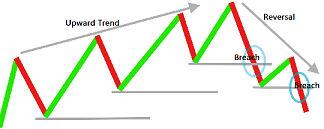
In an upward trend, a clear reversal occurs when the previous low is breached & you begin to see lower lows, & lower highs.
In a downward trend, a clear reversal occurs when the previous high is breached & you begin to see higher highs, & higher lows.
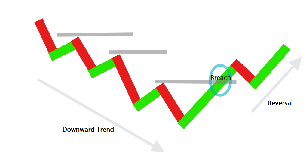
A reversal is not the same thing as a secondary trend or pullback.
In a secondary trend, the previous low or high price is not breached, but in a reversal the previous low or high price is breached.
This tenet of Dows Theory is the building block of technical analysis today.

Leave a Reply